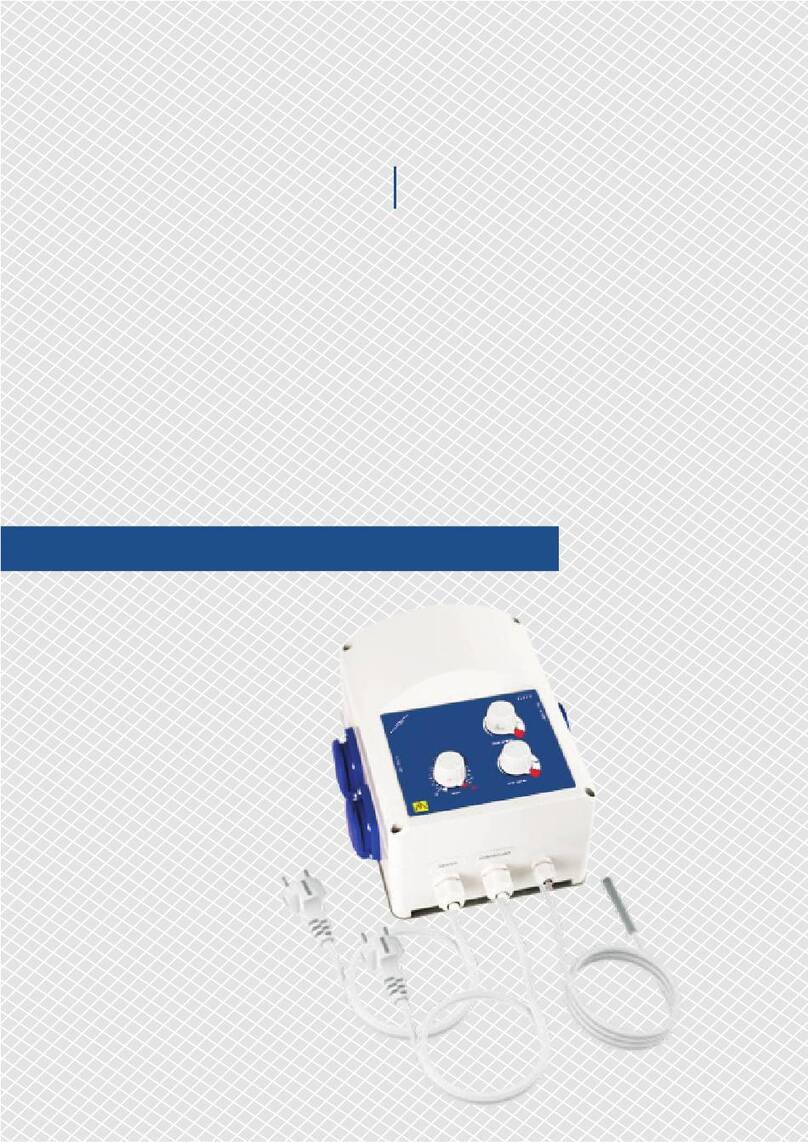
www.sentera.eu
MIW-DXTP-EN-000 - 29 / 09 / 2015 9 - 10
back to the table of contents
MODBUS REGISTER MAPS
INPUT REGISTERS
Data type Description Data Values
1Temperature unsigned int. Actual temperature level 0—500 250 = 25,0 °C
2-10 Reserved, returns 0
11 Analogue output value unsigned int. Value of the analogue output 0—1.000 0 =
1.000 =
0 %
100 %
12 Relay status unsigned int. Relay status. When it is On, the contact between COM1 and NO1 is closed. 0—1 0 =
1 =
Off
On
13 Temperature setpoint unsigned int. Temperature setpoint used for PI control 0—500 250 = 25,0 °C
14 Relay setpoint unsigned int. Relay switching setpoint 0—500 250 = 25,0 °C
15 Hysteresis unsigned int. Hysteresis for the relay switching 1—5
1 =
2 =
3 =
4 =
5 =
1,0 °C
2,0 °C
3,0 °C
4,0 °C
5,0 °C
16 Output mode unsigned int. Analogue and relay output mode (Heat/Cool) 0—1 0 =
1 =
Heat mode
Cool mode
17 Kp value unsigned int. Proportional gain value 1—1.000 10 = 1,0 gain
18 Ti value unsigned int. Integration period value 1—6.000 1 =
100 =
0,1 s
10 s
19-20 Reserved, returns 0
HOLDING REGISTERS
Data type Description Data Default Values
1Device slave address unsigned int. Modbus device address 1—247 1
2Modbus baud rate unsigned int. Modbus communication baud rate 1—4 2
1 =
2 =
3 =
4 =
9.600
19.200
38.400
57.600
3Modbus parity check unsigned int. Parity check mode 0—2 1
0 =
1 =
2 =
8N1
8E1
8O1
4Device type unsigned int. Device type (Read only) DXTPX = 1041
5HW version unsigned int. Hardware version of the device (Read only) XXXX 0 x 0110 = HW version 1.1
6SW version unsigned int. Software version of the device (Read only) XXXX 0 x 0130 = SW version 1.3
7Reserved, returns 0
8Output overwrite unsigned int. Enables the direct control over the outputs 0—1 00 =
1 =
Disabled
Enabled
9-10 Reserved, returns 0
11 Temperature setpoint unsigned int. Temperature setpoint used for PI control 0—500 250 500 = 50,0 °C
12 Relay setpoint unsigned int. Relay switching setpoint 0—500 250 500 = 50,0 °C
13 Hysteresis unsigned int. Hysteresis for the relay switching 1—5 4
1 =
2 =
3 =
4 =
5 =
1 °C
2 °C
3 °C
4 °C
5 °C
14 Kp value unsigned int. Proportional gain value 0—1.000 50 10 = 1,0 gain
15 Ti value unsigned int. Integration period value 1—6.000 100 1 =
100 =
0,1 s
10 s
16 Output mode unsigned int. Selects the analogue and relay output mode (Heat/ Cool) 0—1 00 =
1 =
Heat mode
Cool mode
17-19 Reserved, returns 0
20 Autotune of analogue
output unsigned int. Starts autotune in PI control for the analogue output 0—1
1 =
0 =
Autotune start
(In progress)
Stop (Idle)
21 Analogue output overwrite
value unsigned int. Overwrite value for the analogue output. Always
settable. Active only if holding register 8 is set to 1 0—1.000 00 =
1.000 =
0 %
100 %
22-30 Reserved, returns 0
To find out more about Modbus over serial line, follow this link: http://www.modbus.org/docs/Modbus_over_serial_line_V1_02.pdf
DXTP
DUCT TEMPERATURE CONTROLLER
WITH PI CONTROL




























